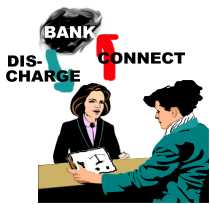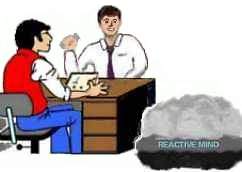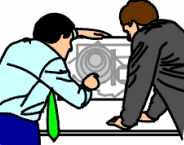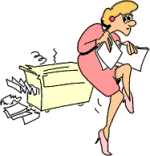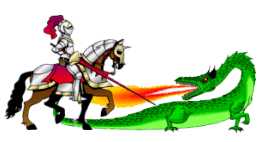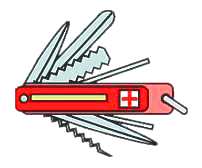|
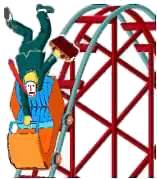 |
A Roller-coaster ride is known
from amusement parks. A PTS
is known to get better then
worse. Better then worse. His
case is on a Roller-coaster.
|
What is PTS
A Potential Trouble Source (PTS) is a specific case
condition or type of case. A person or preclear who gets
better, then worse is said to "Roller-Coaster". This happens
only when the PTS person is connected to a person hostile or antagonistic
to him or her or to what the PTS person is doing. It can be an individual
or a group expressing this hostility and disapproval. Such a person or
group is called an Antagonistic Terminal (AT). If such a relationship or
condition exists it is the first thing to do something about. We know a pc
will not make gains over a Present Time Problem. If a PTS situation exists
it is a Present Time Problem of magnitude and the only thing that should
be addressed until handled. It must be handled for the pc in order to
stabilize him or her. And it must be handled to some degree before any
auditing is attempted as no permanent gains or benefits can be achieved
over such a problem. After such a situation is handled to some
extent by instructing and coaching the pc on how to deal with it and have
him do something about it, the pc should be audited on it. And he
must, in order to make permanent gains from processing, only receive
processing intended to handle such a condition until handled.
 |
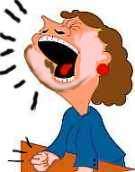 |
A PTS has a Present Time
Problem of magnitude. On
the other side of the problem
is an Antagonistic Terminal.
This problem has to be
handled in the physical
universe before the pc can
benefit from auditing or even
enjoy life and prosper.
|
So a Potential Trouble Source (PTS) is
somebody who is connected to an Antagonistic Person (AT), who is
invalidating him, his beingness, his processing, his life. It means the
case is going to go up and fall down. He's a trouble source because he's
going to get upset. He's a trouble source because he's going to make
trouble. And he's trouble for the auditor and he's trouble for people
around him and he's trouble for himself. He is connected to a person or
group opposed to him or processing or what he does in life. It is a
technical thing. It results in illness and roller-coaster and is the cause
of illness and roller-coaster.
Handling PTS Conditions
PTS situations can come about at any time. It can happen while a person is
being audited or it can happen in daily life. For a pc receiving auditing
or service it is a top priority to address and handle it right away. It
has to be done competently to get the person back on his feet and back in
auditing or training. Many pc's new to ST need a PTS handling as one of
their first actions.
Auditing or training must not be done or continued over an unhandled PTS
situation. It would cause any processing or study to be done under the
heavy stress from the antagonism or suppression.
When you see such a situation you do not just go on hoping or try to
ignore it. You have to look at it head on and handle it. Handling
PTS situations is not difficult. There is no excuse for not doing it. The
data and steps below lay out the many different handlings which can be
used to bring about a full resolution of all PTSness in all pcs.
|

|
Educating the PTS is an
important first step as she is
often the last one to suspect
it. She may not be ready
to accept the facts without
a good explanation.
|
Education
A person who has become PTS is often the last person to suspect it. He or
she may have become PTS in a stressed situation and it is often a
temporary condition. Sometimes his condition is very light. But he may
also have been PTS for a long time and gotten so used to it so 'that's
life' to him. Whatever the case may be the first step is to educate the
person in the subject.
PTS Basic Definitions
The PTS Basic Definitions, given in this section, must be done
before any other PTS handling is done.
Clearing the basic ideas and concepts prepares a person enough to
understand his own PTS situation and the mechanisms involved. This is an
important first step and it is always done.
PTS Interview
Once the pc has been educated in the basic definitions a metered PTS
interview can be done. The pc can also be given a "PTS Assist".
This is usually done on a Meter by an auditor in session or another
knowledgeable person (but it don't have to be metered). In most cases such
an Assist will help the person to spot the antagonistic or suppressive
element. Once the AT is found the potential trouble source can be assisted
in working out a handling for that terminal. If it is not a terminal the
pc depends on the simplest handling can be to cease contact. If the PTS
person depends upon that terminal a handling should be worked out. There
are a lot of data written on this subject, including chapters in the books
"Introduction to Scn Ethics" and "Volunteers Minister's
Handbook". In this manual we concentrate on the auditing side and
will have to refer the student to these books to get an in-depth coverage
of it. If the AT cannot easily be found the pc may have more 'case'
related to the situation or condition. There are different categories of
PTS situations. In the simplest form the pc is under attack in present
time from a source that easily can be found. This is called PTS Type One
(or Type A). A not uncommon situation is PTS Type Two. Here the condition
depends on a past PTS situation being restimulated by present dangers or
persons. This need to be addressed by a qualified auditor with actions
like the Audited PTS RD.
Suppression and Entheta
Antagonistic persons usually use and speak entheta. Entheta
means Enturbulated thought or life; this is especially destructive
communications based on lies and wanting to spread confusion in an attempt
to overwhelm or suppress the PTS person. Entheta has no power in itself
but feed on theta in a parasitic fashion.
This is an important datum as it is often the PTS person that
"feeds" the suppressive terminal. Thus by working with the PTS
person you can find out what he or she is doing to fuel the situation and
have him change that. In some instances disconnection is the only workable
option. You cut the feed-line completely and the entheta will stop.
Physical
Universe Handling
Once an antagonistic terminal has been located a handling is done. This is
done outside session, usually by a so-called Ethics Officer. To handle the
pc's Present Time Problem takes physical action. We had the definition of
a PTP as: "A specific problem that exists in the physical universe
now, on which a person has his attention fixed. This can be practical
matters he feels he ought to do something about right away. Any set of
circumstances that occupies the pc's attention so he feels he should do
something about it instead of being audited". This is exactly what
you have in a PTS situation. And the way to go about it is to do something
about it. Such a handling should move the PTS person from being
effect of the situation to a point where he can take a bit of
responsibility for it. He is gradually moved towards being cause over the
situation. This handling can include writing letters, making phone calls,
handle whatever he is continuously being attacked for or simply tell him
to make up his mind about something and act on it - whatever it takes to
get the result. The handling and course of action depend on the
person and the situation.
A "good roads, good weather-approach" to the antagonistic
terminal is usually what is needed. The handling must be understood and accepted by the
PTS person and the person assisting him must be focused on putting the PTS
at cause step by step.
Handling may include coaching him along and
look for things that brought about the PTS condition in the first
place. Did the pc antagonize the AT in some way out of lack of
concern or rudeness? Did he mis-apply any basic data, such as ARC
and the tone scale? Such factors should be looked into and the PTS person
instructed accordingly. Often simple measures and good
manners, 'Good
Roads and Fair Weather' will go a long way. Also 'Living
with Right and Wrong' can be useful.
It will often be found, that a PTS situation exists
between the pc and his or her parents. The situation can be due to the
pc's rebelliousness or the parents lack of understanding and respect of
the pc as an independent individual. They may 'have other plans' for the
pc than what is right for him or her to do. There are a lot to be said for
a person skilled in handling PTS situations, but we will have to refer the
student to the above mentioned books for in-depth data.
 |
The handling is best done with
a written program. The pc is given
a step-by-step write up. It includes
things to read, phone calls and letters
to do; drilling in handling her situation
and actually doing that for real.
|
Program
The PTS handling is best done with a written program. When the PTS person
has been interviewed and the matters and situation discussed, the Ethics
Officer or handler should write a step by step program for the PTS person
to do. It may contain things to read, things to drill, and things to do.
It is a good idea to drill the PTS person on how to handle the situation
in a practical sense. You simply run the person through what to say and
how to act in relationship to the AT and correct anything that would make
the situation worse.
Example: The following is based
on a real case story. You want to coach the pc from effect to being cause.
When the PTS person starts to become more cause over the situation the
whole thing tends to cool off. The communication formula is "Cause -
Distance - Effect" in its simplest form. We once handled a young
woman being PTS to her mother. The daughter was living and working in
another country now. She had these long phone conversations with the
mother, the antagonistic person (AT). Not only was the mother giving her
daughter a hard time, the calls were also expensive. We instructed and
drilled the PTS person in what basically amounted to TR-2 and TR-4,
acknowledgment and handling originations. This was after listening in on
one conversation, where the daughter got very upset and apparently the
mother went on and on. The AT mother was basically trying to get the
daughter not to study or do ST nor receive auditing. Her mother was used
to run her daughter's life and the present situation upset her. So we
drilled the daughter in handling this kind of criticism and attempts of
dominating control. An important point was simply acknowledgment. There
were several more steps, of course, but this was really the one little
thing that turned it around. The next time she talked to her mother the
daughter just did what she had drilled. She listened and acknowledged with
little comment. The comments she did make were well prepared and
drilled. After all, each phone conversation was not much different from
the previous so responses could be worked out beforehand. When you give an
acknowledgment you are occupying the Cause end of the comm formula, you
see. You are controlling the other person's comm to an extent. Not only
was the daughter's phone bill only a fraction of the previous ones - which
all by itself gave her some relief - she also realized she could do something
about her mother without having to generate more antagonism. She realized
she could control her mother's communication and not only be at Effect but
also at Cause.
It may not always be that simple. Yet, beginning
steps are usually best tackled with a light approach. You are starting to resolve the situation.
If the situation does not seem to resolve with
physical handlings alone the PTS person may need an Audited PTS program.
There may exist a PTS Type Two situation, where the real problem is
restimulation and the actual source and incidents behind are unknown to
the pc. There exists a line-up of techniques and Rundowns, designed
to handle that:
Rudiments
Flying rudiments and overts on four flows on the antagonistic terminal is
often done to "get the ruds in" and enable the pc to better
confront the PTS situation he is faced with. This would of course only be
done in session by a qualified auditor. The commands for this can be found
as part of the audited PTS RD. This step can be done when the full PTS RD
seems like an over-kill.
The PTS Rundown
The Audited PTS Rundown is done on preclears who have had successful PTS
handlings, but is found to get sick or roller-coaster at a later time. Pc
becomes ill, slumps after making gains, or continues to find
additional terminals they are PTS to. Obviously there is more work to be
done.
The PTS Rundown handles a pc's PTSness in more depth and is run to the end
phenomena of a pc who is getting and keeping case gains and never again
roller-coasters.
Suppressed Person Rundown
This Rundown is simple, yet very effective. It can be done with great
success on all PTS persons of any case level, from those just beginning
their first auditing to Clears and above.
The end phenomena of this RD is a surprising - miraculous you could say -
re-establishing of communication between the AT and the PTS. At some point
of the RD the Antagonistic Terminal will actually
originate such a communication to the pc.
Rest and Quiet
There is such a condition as a PTS Type Three situation. In daily language
this is called a nervous breakdown or a psychotic break. The person has
been totally overwhelmed by the antagonism, hostility and evil intentions
he or she is subject to. If this should happen to a person in your care or
happen to a person you know, the best thing to provide is rest, quiet, and
a safe environment. The thing not to do is to run to the pharmacy
to get 'nerve tablets' or any other drugs. Drugs may cover up the
symptoms, but it is not a cure. To remove sources of restimulation from
the environment is the best first aid. You may have to remove the person
from where he or she lives as persons around and the environment keeps him
restimulated. The real reason for the Type Three condition is however
heavy BPC on terminals located in the PTS person's Bank but having to do
with suppression.
A PTS Type Two condition exists, when the AT
in the environment is only the apparent suppressive person (SP) or
antagonistic terminal (AT). On the pc's track there will be a real
suppressive person, unknown to the pc, that some time in the past created
such a chaos and threat, that the pc has it in restimulation all the time.
That is why it has to be found in auditing. The real source of suppression
is not in the pc's present environment or an associate - even when the pc
feels and thinks it is. This can be handled with the PTS RD. This is
relatively easy to handle when caught in time.
When we talk about a PTS Type Three situation we
are talking about a severe and acute restimulation of a Type Two
condition. The apparent AT and the SP's on the pc's track are suddenly
spread all over the world. Any contact with any human can set this
restimulation off. It's a total A=A=A in action on any human being. It can
include more than all the people in the world. The person may sometimes
include ghosts or demons and imaginary beings as well. Peace
and quiet is the best first aid. Healthy food, safe environment, big solid
objects to touch. Gentle care and minimal 'treatment' of any kind.
Eventually the thing will destimulate and key out. When the person feels
stable and well enough the pc can be given light touch auditing and
eventually be run on a PTS RD which is the real cure. In dealing with PTS
Type Three any assignments and therapy should be done observing the effect
scale.
(Note: We use the term Antagonistic
Terminal as the type of terminal a person goes effect to (PTS). It wasn't
defined clearly this way until 1978 in the Suppressed Person RD. Quote: "...an
antagonistic terminal... Where this terminal was antagonistic,
invalidative, hostile or downright suppressive, he will suddenly have a
change of heart and seek to make peace with the PTS pc."
The term Suppressive Person (SP) was the original term used for the
person the PTS goes effect to. It was defined by R. Hubbard as an
anti-social personality (1965) or what in psychiatry is called a
'psychopath' and in popular culture, the villain - somebody operating on
evil purposes. But at some point in Scn it became practice to declare
critics, opponents and 'political dissidents' for 'SP'. This eroded the
term for technical meaning, clarity and usefulness as it now simply meant
a 'bad guy'. In ST we still use the term 'SP' in a narrow technical
sense (as originally defined), when called for, as they do exist. But our
general term is Antagonistic Terminal (AT) as it is used in Suppressed
Person RD.
It also became clear over the years
(between 1965 when 'SP' was first defined and 1971 when the Audited PTS RD
first came out) that the "SP/PTS tech" had a much broader
application than just handling the bad influences of true SP's on the pc. We
have elevated the use of Antagonistic Terminal as a new technical term for
what we have actually been handling all along. As most PTS situations
have to do with all kinds of antagonism and confrontational situations and
only occasionally true SP's, we call such persons or groups for
Antagonistic Terminals and use the abbreviation AT for such terminals. The
technology in this area we simply call PTS technology (not SP/PTS
technology). The pc can go PTS and this is the tech for handling that. The
focus is the pc. The true SP is outside the realm of individual
practitioners to deal with and remains 'the villain'. It may be possible
to develop institutions that can deal with these types of cases based on
the technology (clinical tests for diagnosis do not exist at this time.
Only production records seem to give a somewhat reliable clue). But such
projects would have to be very well funded and have solid back-up from the
medical profession before they should be undertaken.
|


